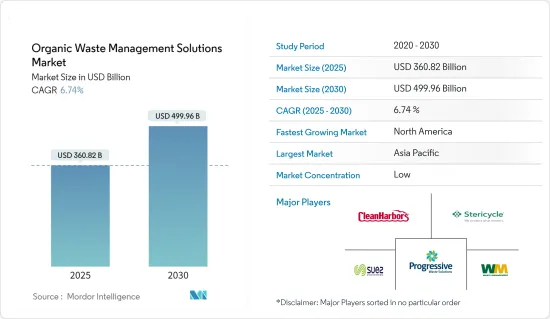PUBLISHER: Mordor Intelligence | PRODUCT CODE: 1636425

PUBLISHER: Mordor Intelligence | PRODUCT CODE: 1636425
Organic Waste Management Solutions - Market Share Analysis, Industry Trends & Statistics, Growth Forecasts (2025 - 2030)
The Organic Waste Management Solutions Market size is estimated at USD 360.82 billion in 2025, and is expected to reach USD 499.96 billion by 2030, at a CAGR of 6.74% during the forecast period (2025-2030).

Nature predominantly generates organic waste. As waste management gains traction, especially in urban centers, the need for effective organic waste management and recycling has surged. Urban organic waste, with its high moisture content, not only bulks up garbage but also hampers incineration by lowering temperatures. Globally, a spectrum of treatment methods has emerged to tackle these challenges.
Increasing emphasis on eco-friendly waste management, coupled with rising public environmental consciousness, is fueling significant growth in the organic waste sector. Advancements in garbage sorting and processing technologies, such as biogas generators, automated sorting systems, and anaerobic digesters, are enhancing the efficiency of organic waste management. Effective management of organic waste is crucial not only to curb its environmental impact and greenhouse gas emissions but also to foster a circular economy, transforming waste into valuable resources.
Organic Waste Management Solutions Market Trends
Rising Demand for Eco-friendly Waste Management Solutions in the Commercial Sector
As the environmental and health benefits of proper wet waste management gain recognition, the call for enhanced garbage collection and disposal services amplifies. Notably, businesses in the hospitality sector, including restaurants and hotels, actively seek waste management firms that champion eco-friendly strategies. This heightened awareness in the commercial sector not only spurs interest in sustainable practices but also fosters a sense of environmental responsibility.
Moreover, initiatives like waste-to-energy, exemplified by biogas production and anaerobic digestion, present a sustainable avenue for transforming food waste into valuable resources. By adopting these methods, not only is landfill dumping reduced, but organic waste is also harnessed to generate renewable energy. This dual benefit not only aids in waste reduction but also contributes to the demand for alternative energy sources and environmental conservation. Consequently, organic waste management in commercial establishments witnesses a surge in demand, propelled by the continuous evolution of these technologies and the increasing acknowledgment of their economic and environmental advantages.
Asia-Pacific Poised to Lead Organic Waste Management Market
Forecasted for the coming years, Asia-Pacific stands at the forefront of the organic waste management market. The surge in urbanization and population has directly correlated with a rise in waste generation, notably moist waste from households and businesses. Many APAC nations have bolstered their waste management regulations, emphasizing correct handling and disposal of wet waste. These regulations are crafted to not only reduce landfill waste but also to promote recycling and composting. The region has not shied away from innovative approaches, with endeavors like expansive composting facilities and the conversion of organic waste into biogas gaining traction.
Substantial investments are flowing into the Asia-Pacific waste management sector, earmarked for expanding capacities, adopting new technologies, and bolstering infrastructure. Moreover, the adoption of advanced technologies, like intelligent bins and waste-tracking systems, is rising. Despite its advancements, Asia-Pacific grapples with food losses in its supply chain, presenting a clear opportunity for waste reduction and sustainable food initiatives.
Organic Waste Management Solutions Industry Overview
The organic waste management solutions market is fragmented, with several key players operating globally and regionally. These companies focus on technological innovations, partnerships, and expansions to strengthen their market presence. Some of the major players include Waste Management Inc., Clean Harbors Inc., Progressive Waste Solution Ltd, Suez Environment, and Stericycle.
Additional Benefits:
TABLE OF CONTENTS
1 INTRODUCTION
- 1.1 Study Assumption and Market Definition
- 1.2 Scope of the Study
2 RESEARCH METHODOLOGY
3 EXECUTIVE SUMMARY
4 MARKET DYNAMICS AND INSIGHTS
- 4.1 Market Overview
- 4.2 Market Drivers
- 4.2.1 Stringent Regulations and Policies Promoting Waste Management
- 4.2.2 Increasing Adoption of Anaerobic Digestion Technologies
5 MARKET SEGMENTATION
6 COMPETITIVE LANDSCAPE
7 FUTURE MARKET TRENDS
8 DISCLAIMER AND ABOUT US




